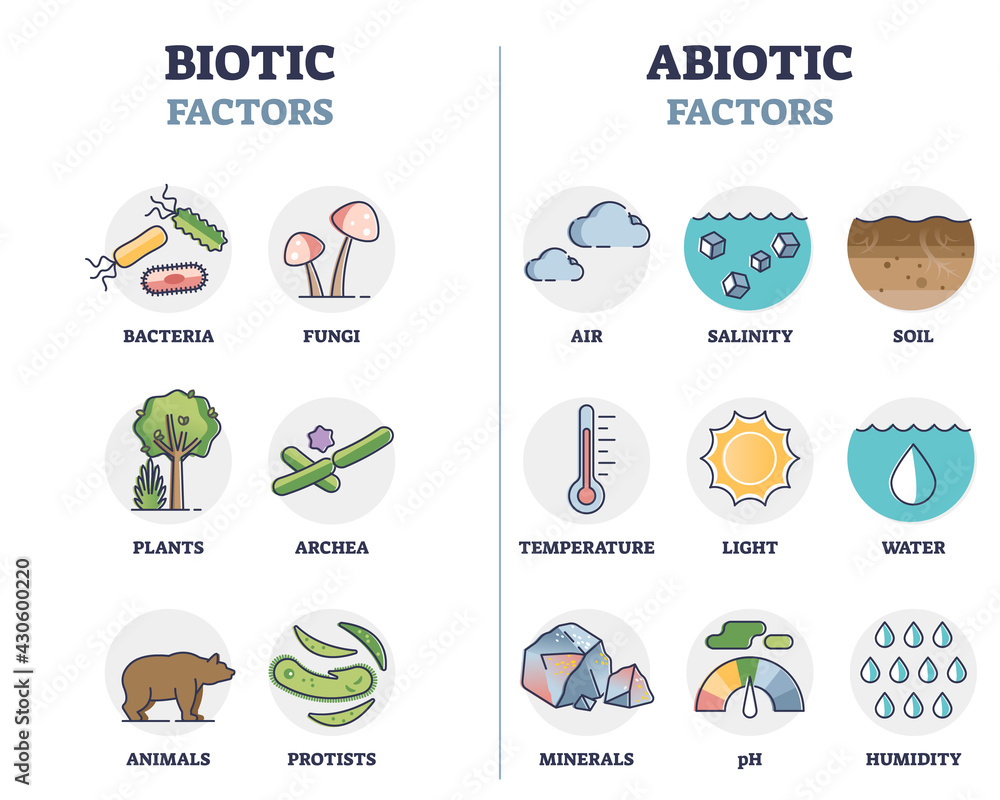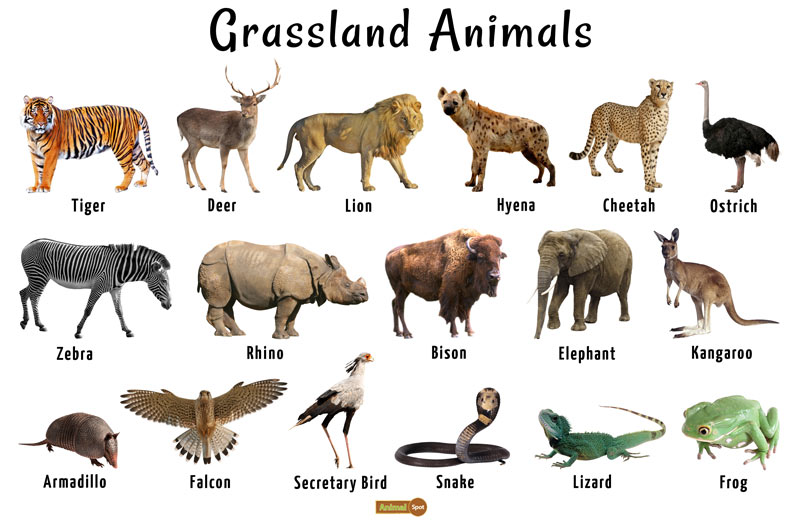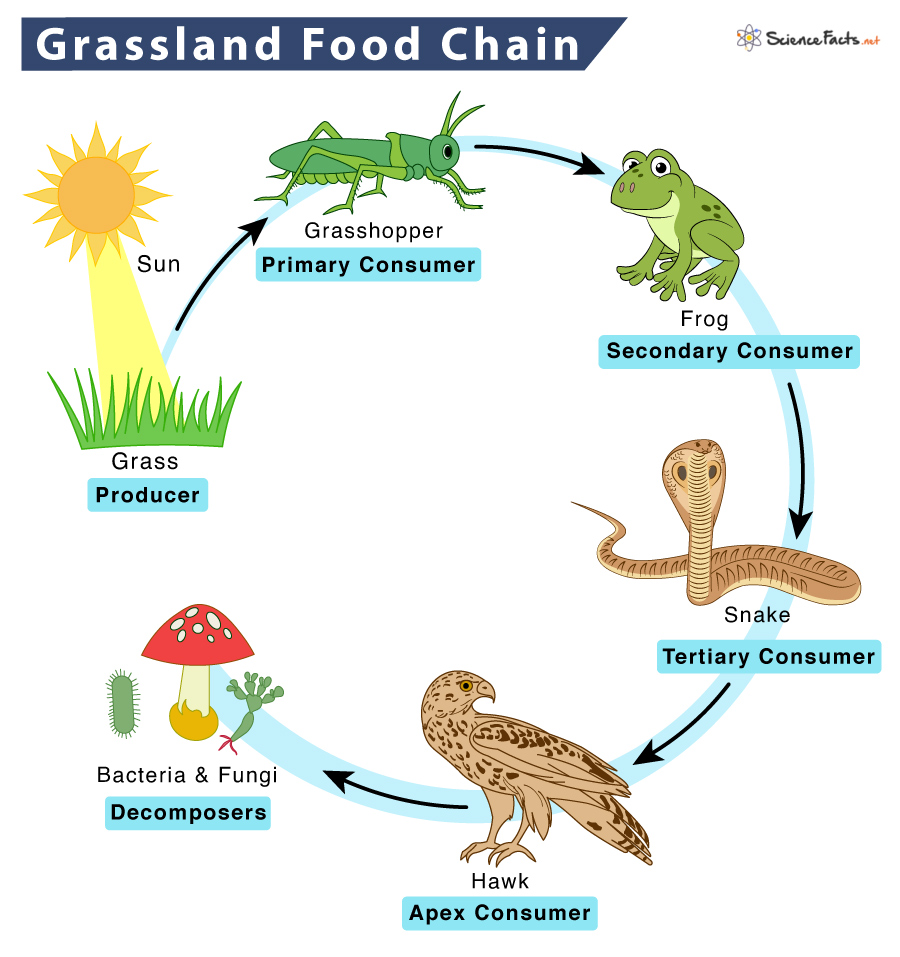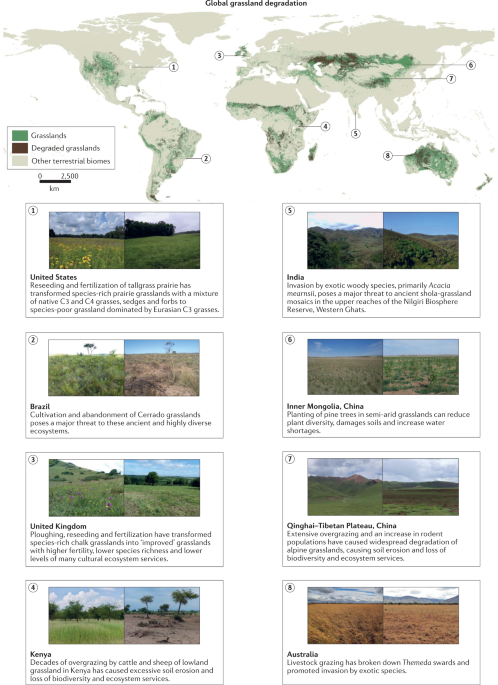Topic abiotic components in an ecosystem: Discover the pivotal roles of abiotic components in an ecosystem, exploring how elements like water, light, and temperature fundamentally shape biodiversity and ecological balance.
Table of Content
- What are the abiotic components in an ecosystem?
- Overview of Abiotic Factors
- Importance of Abiotic Components in Ecosystems
- Types of Abiotic Factors
- Role of Temperature in Ecosystems
- Water"s Influence on Ecosystem Dynamics
- Light as a Critical Abiotic Factor
- YOUTUBE: Abiotic Factors in Ecosystems: Water
- Soil Composition and Its Effects on Ecosystems
- Air Quality and Its Impact on Ecosystem Health
- How Abiotic Factors Affect Biodiversity
- Abiotic Stress and Ecosystem Resilience
- Monitoring and Managing Abiotic Components for Sustainability
What are the abiotic components in an ecosystem?
The abiotic components in an ecosystem are non-living factors that have an impact on the environment and interact with living organisms. These abiotic factors shape and influence the ecosystem in various ways. Here is a list of some common abiotic components:
- Temperature: The average weather conditions, including hot and cold extremes, affect the growth and development of organisms.
- Light: The amount and intensity of sunlight determine the availability of energy for photosynthesis and affect the behavior and adaptation of organisms.
- Moisture: The amount of water available in different forms, such as liquid, vapor, or ice, affects the survival and distribution of organisms.
- Atmosphere: The composition and concentration of gases in the air, such as oxygen, carbon dioxide, and nitrogen, play a crucial role in respiration and photosynthesis.
- Soil: The properties of soil, including its texture, composition, and nutrient content, influence the growth and development of plants and the organisms that depend on them.
- Chemical factors: Other chemical factors like pH, salinity, and the presence of pollutants can have significant impacts on the survival and health of organisms.
These abiotic components interact with each other and with the biotic components (living organisms) to create a complex and interconnected ecosystem. Understanding the interactions between abiotic and biotic components is essential for studying and managing ecosystems.
READ MORE:
Overview of Abiotic Factors
Abiotic factors are the non-living chemical and physical components of the environment that significantly influence the behavior and survival of organisms in an ecosystem. These factors play a crucial role in shaping the ecosystem"s structure and the distribution of living organisms within it. Understanding abiotic factors is essential for grasping how ecosystems function and the complex interactions between all living and non-living components.
- Temperature: A key determinant of the distribution of organisms, as different species thrive in varying temperature ranges.
- Water: Essential for life, the availability of water affects the type of vegetation and animal life in an area.
- Light: Sunlight is crucial for photosynthesis, and thus influences where plants can grow and, by extension, where animals can live.
- Soil: The composition, pH, and texture of soil determine the types of plants that can grow in an ecosystem.
- Air: The composition of the atmosphere, especially oxygen and carbon dioxide levels, affects the life forms that can thrive in an environment.
These abiotic factors do not exist in isolation but interact with each other to create a unique habitat. For instance, soil quality can affect water drainage and retention, which in turn influences the types of plants that can grow, impacting the animals that rely on those plants for food and habitat. Similarly, temperature and light availability can affect the rate of photosynthesis, influencing plant growth and the types of vegetation that dominate an area. Recognizing the importance of abiotic factors is crucial for understanding ecological balance and the sustainability of ecosystems.

Importance of Abiotic Components in Ecosystems
Abiotic components play a foundational role in ecosystems, influencing the survival, growth, and distribution of organisms. They are critical in determining the structure of ecosystems and in shaping the interactions between biotic and abiotic elements. The balance and health of ecosystems depend significantly on these non-living components.
- Regulation of Biological Processes: Temperature, sunlight, and water availability directly influence photosynthesis, respiration, and other vital biological processes.
- Formation of Habitats: The physical characteristics of the environment such as soil type and water bodies form habitats that support diverse living organisms.
- Biodiversity Support: Variation in abiotic factors contributes to the diversity of ecosystems by creating different niches that can be occupied by a variety of species.
- Impact on Population Dynamics: Factors like temperature and water availability can limit the distribution and abundance of species, affecting the overall population dynamics within an ecosystem.
- Ecosystem Services: Abiotic components are integral to ecosystem services that benefit humanity, including water purification, climate regulation, and nutrient cycling.
Understanding the importance of abiotic components in ecosystems is essential for conservation efforts and for managing natural resources sustainably. These components not only support life but also define the very framework within which ecosystems operate, making their study and preservation crucial for ecological balance and for the well-being of the planet.
Types of Abiotic Factors
Abiotic factors, the non-living elements that influence ecosystems, vary widely and have critical impacts on the structure and function of ecosystems. These factors include:
- Climate Factors: Encompassing temperature, sunlight, and precipitation, these factors determine the overall environmental conditions of an ecosystem.
- Edaphic Factors: Related to soil, including its texture, composition, pH, and moisture content, edaphic factors affect the types of vegetation that can thrive.
- Topographic Factors: The physical features of the landscape, such as elevation, slope, and aspect, influence microclimates within ecosystems.
- Hydrological Factors: These include all aspects related to water, such as availability, chemical properties, and flow patterns, crucial for aquatic and terrestrial habitats.
- Chemical Factors: The concentration of nutrients and pollutants, pH levels, and the presence of organic and inorganic substances in the soil and water.
- Atmospheric Factors: Encompass air quality, wind patterns, and atmospheric pressure, which can influence temperature, precipitation, and gas exchange processes.
Each of these abiotic factors plays a specific role in shaping ecosystems, influencing the distribution, behavior, and survival of organisms. By understanding these factors, we can better appreciate the complexity of ecosystems and the intricate balance that sustains life on Earth.

Role of Temperature in Ecosystems
Temperature plays a vital role in ecosystems, affecting the physical environment, biological processes, and species distribution. As a primary abiotic factor, it influences the growth, reproduction, and survival of organisms. The role of temperature is multifaceted and impacts ecosystems in several ways:
- Regulating Metabolic Rates: Temperature directly affects the metabolic rates of organisms. Higher temperatures typically increase metabolic rates, enhancing growth and activity levels, whereas lower temperatures reduce metabolic functions.
- Determining Species Distribution: Different species have specific temperature ranges within which they can survive. Temperature limits the geographical distribution of flora and fauna, with some species adapted to cold environments and others to warmer conditions.
- Influencing Phenological Events: Temperature cues many seasonal activities in organisms, such as migration, breeding, and flowering. Changes in temperature patterns can disrupt these natural cycles, impacting ecosystem dynamics.
- Affecting Ecosystem Productivity: Temperature influences photosynthesis rates in plants, which in turn affects primary productivity. Ecosystems in warmer regions tend to have higher rates of primary productivity compared to those in colder regions.
- Impacting Water Availability: Temperature plays a crucial role in the hydrological cycle, affecting evaporation rates, precipitation patterns, and consequently, the availability of water in ecosystems.
The role of temperature in ecosystems underscores the delicate balance required for ecological stability. It highlights the interconnectedness of abiotic factors and their collective impact on biodiversity and ecosystem health.
Water"s Influence on Ecosystem Dynamics
Water is a fundamental abiotic component that influences ecosystem dynamics in profound ways. Its availability, quality, and movement shape the living world, affecting the distribution of plants, animals, and microbial life. Water"s influence extends across various aspects of ecosystem functioning:
- Supporting Life: Water is essential for all biological processes, from photosynthesis in plants to metabolism in animals.
- Shaping Habitats: Aquatic and terrestrial habitats are directly shaped by the presence and flow of water, creating diverse ecological niches.
- Regulating Climate: Water bodies moderate temperatures, influencing local and global climate patterns.
- Facilitating Nutrient Cycling: Water movement transports nutrients across ecosystems, enabling the recycling of essential elements.
- Determining Biodiversity: The variety and availability of water sources are key determinants of species diversity within an ecosystem.
Water"s role in ecosystems underscores its importance in maintaining ecological balance and supporting biodiversity. From rivers and lakes to groundwater and precipitation, the dynamic nature of water interacts with the landscape, climate, and living organisms, illustrating the interconnectedness of abiotic and biotic components in the natural world.

Light as a Critical Abiotic Factor
Light is a crucial abiotic factor in ecosystems, fundamentally influencing the energy budget, photosynthetic activity, and behavioral patterns of organisms. Its availability and intensity can determine the structure and function of habitats:
- Photosynthesis: Light drives photosynthesis, the process by which plants, algae, and some bacteria convert light energy into chemical energy, producing the oxygen and organic compounds that sustain most life forms.
- Plant Growth: The quality, intensity, and duration of light affect plant growth rates, morphology, and the timing of flowering and fruiting.
- Behavioral Responses: Light influences the behavior of animals, including migration, feeding, and reproductive cycles. Many species have evolved to take advantage of the diurnal and seasonal variations in light.
- Ecological Niches: Variations in light availability create different ecological niches, supporting a diversity of life forms in both terrestrial and aquatic environments.
- Energy Distribution: Light intensity affects the temperature and microclimate of ecosystems, thereby influencing the distribution of species across different habitats.
Light"s role extends beyond mere energy provision; it shapes ecosystems through complex interactions with other abiotic and biotic factors. By understanding light as a critical abiotic factor, we can appreciate its fundamental contribution to the biodiversity and productivity of ecosystems.
Abiotic Factors in Ecosystems: Water
Dive into the refreshing world of water in this captivating video that showcases the mesmerizing beauty of ocean waves, serene lakes, and cascading waterfalls. Immerse yourself in the tranquil sounds and captivating visuals that will rejuvenate your senses.
GCSE Biology: Biotic and Abiotic Factors
Explore the fascinating realm of biotic life in this awe-inspiring video that highlights the incredible diversity and interconnectedness of living organisms. Witness the intricate webs of life as plants, animals, and microorganisms come together to create a harmonious ecosystem.
Soil Composition and Its Effects on Ecosystems
Soil composition, a critical abiotic factor, significantly influences ecosystem dynamics. The type, texture, and nutrient content of soil not only affect plant growth but also have far-reaching effects on the biodiversity and productivity of ecosystems:
- Plant Growth and Diversity: Soil quality determines the types of plants that can grow in an ecosystem, influencing the entire food web.
- Water Retention and Drainage: Soil texture affects its ability to retain water, impacting plant hydration and the availability of water for organisms.
- Nutrient Cycling: The composition of soil influences the cycling of nutrients, such as nitrogen and phosphorus, essential for plant growth.
- Support for Microbial Life: Soil provides a habitat for a vast array of microbial life, which plays a crucial role in decomposing organic matter and nutrient cycling.
- Habitat Formation: Variations in soil composition can lead to the formation of different habitats, such as forests, grasslands, and wetlands, each supporting unique ecosystems.
The interaction between soil composition and other abiotic factors, like climate and topography, further defines the ecological character of an area. Understanding soil composition is vital for conservation efforts, sustainable agriculture, and the management of natural resources, highlighting its foundational role in supporting life on Earth.

Air Quality and Its Impact on Ecosystem Health
Air quality is a significant abiotic factor affecting ecosystem health. The composition and cleanliness of the atmosphere have far-reaching effects on biological communities, influencing the health, distribution, and diversity of plant and animal species:
- Photosynthesis: Clean air is vital for photosynthesis, the process by which plants convert carbon dioxide and sunlight into oxygen and glucose. Pollutants in the air can reduce the efficiency of this process, impacting plant growth and the overall productivity of the ecosystem.
- Respiration: Air quality affects the respiratory health of all organisms. Poor air quality can lead to respiratory problems in animals and humans and can inhibit plant respiration, affecting growth and survival.
- Climate Regulation: The composition of the atmosphere plays a crucial role in climate regulation. Greenhouse gases, such as carbon dioxide and methane, contribute to climate change, which can alter ecosystem dynamics globally.
- Pollutant Deposition: Airborne pollutants can deposit on land and water, affecting soil chemistry, water quality, and subsequently, the health of terrestrial and aquatic ecosystems.
- Biodiversity: Air quality impacts biodiversity by influencing the health and distribution of species. Polluted environments may lead to a decline in species diversity and affect the balance of ecosystems.
Improving air quality is essential for protecting ecosystem health and ensuring the sustainability of our planet"s diverse habitats. By understanding and mitigating the impacts of air pollution, we can preserve the vital functions and services ecosystems provide.
How Abiotic Factors Affect Biodiversity
Abiotic factors play a crucial role in shaping biodiversity within ecosystems. These non-living components determine the conditions under which different forms of life can thrive. The influence of abiotic factors on biodiversity manifests in several key ways:
- Defining Habitats: The specific characteristics of abiotic factors such as soil type, water availability, and light intensity define the habitat"s suitability for various species, thus influencing the diversity of life in an area.
- Influencing Species Distribution: Temperature, humidity, and other climatic conditions determine the geographic distribution of species. Changes in these factors can lead to shifts in species ranges, affecting overall biodiversity.
- Controlling Population Dynamics: Abiotic factors such as natural disasters, climate change, and pollution can directly impact population sizes and the survival of species, thereby influencing biodiversity levels.
- Shaping Community Interactions: The availability and distribution of essential abiotic resources like water and nutrients affect the interactions among species, including competition, predation, and symbiosis, which in turn shape community structure and diversity.
- Driving Evolutionary Pressures: The variability and extremities of abiotic factors can create selective pressures that drive evolutionary changes, leading to the emergence of new species and the extinction of others, thus affecting biodiversity over time.
Understanding the impact of abiotic factors on biodiversity is essential for conservation efforts, as it helps identify the conditions necessary for the survival of diverse species and the maintenance of healthy ecosystems.
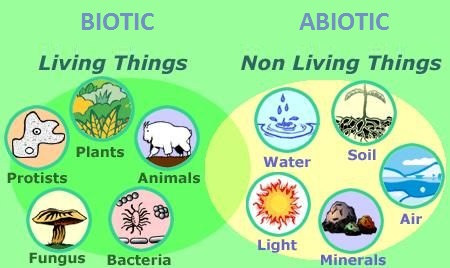
Abiotic Stress and Ecosystem Resilience
Abiotic stress refers to the negative impact of non-living factors on the organisms within an ecosystem, affecting their growth, health, and survival. Ecosystem resilience is the ability of an ecosystem to recover from disturbances and stresses. Understanding the relationship between abiotic stress and ecosystem resilience is essential for managing and protecting natural habitats:
- Types of Abiotic Stress: This includes extreme temperatures, drought, flood, pollution, and nutrient deficiencies, each affecting ecosystems in unique ways.
- Impact on Plant Life: Abiotic stress can limit photosynthesis, reduce growth, and even cause plant death, leading to decreased biodiversity and productivity.
- Animal Populations: Stress factors such as extreme heat or cold can directly impact animal survival, reproduction rates, and migration patterns.
- Soil Degradation: Erosion, compaction, and chemical pollution are forms of abiotic stress that degrade soil quality, affecting plant life and the entire ecosystem.
- Water Resources: Changes in precipitation patterns and water availability due to abiotic stress can alter aquatic and terrestrial habitats.
Ecosystem resilience against abiotic stress can be enhanced through conservation efforts, sustainable management practices, and restoration projects. These actions help maintain biodiversity, support ecosystem functions, and ensure the long-term health of natural environments.
READ MORE:
Monitoring and Managing Abiotic Components for Sustainability
Effective management and monitoring of abiotic components are essential for the sustainability of ecosystems. Understanding and mitigating the impacts of these non-living factors can lead to healthier, more resilient ecosystems. Key strategies include:
- Environmental Monitoring: Regular assessment of air and water quality, soil conditions, and climate factors to detect changes or trends that may affect ecosystem health.
- Sustainable Resource Use: Implementing practices that ensure the sustainable use of water, soil, and other abiotic resources to prevent degradation and depletion.
- Climate Change Mitigation: Reducing greenhouse gas emissions and enhancing carbon sequestration efforts to combat climate change and its impact on ecosystems.
- Pollution Control: Implementing measures to reduce air, water, and soil pollution, thereby protecting organisms and their habitats from harmful substances.
- Restoration Projects: Rehabilitating degraded ecosystems through reforestation, wetland restoration, and soil conservation to restore ecological balance.
- Adaptive Management: Using scientific knowledge and monitoring data to adapt management practices in response to environmental changes and ensure ecosystem resilience.
By closely monitoring and managing abiotic components, we can protect ecosystem services that are vital for biodiversity, human health, and economic development. This holistic approach supports the sustainability of natural systems and promotes a balance between human activities and environmental conservation.
Exploring the vital role of abiotic components unveils the intricate balance of ecosystems. Understanding these elements fosters appreciation and drives actions towards sustainability, ensuring the resilience and health of our planet"s diverse habitats.

